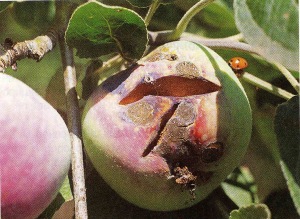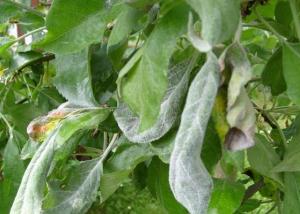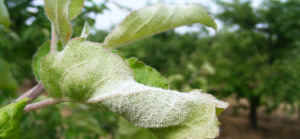Powdery mildew of an apple tree - is it so scary?
Gardeners who inherited a plot with fruit trees, for example, by inheritance, should know that most of the plants are susceptible to numerous diseases. The appearance of bumps, dark spots or dying off of the bark, rot on the fruit can all be caused not only by excessive watering or a hot climate. One of the most common diseases is powdery mildew of apple and other plants.
Content
What is powdery mildew?
Apple powdery mildew is a fungal disease caused by powdery mildew fungi (Erysiphales), a dangerous parasite for many plants. There is the so-called downy mildew, a disease not only of trees and bushes, but also of other plants. Its causative agents are parasitic fungi of the phycomycete class. As a rule, this disease affects the green part of the plant, mainly the leaf.
The marsupial fungus forms a mycelium, which is attached by appressoria directly to the feeding organs of the plant, from which haustoria penetrate deep into the tissues. On such superficial myceliums, in the spring and summer period, abundant conidial sprinkling develops, after which the stage of cleistotecia with ascospores and bursae is formed.
In most of the pathogens, the mycelium is often annual; it dies off together with the infected part of the plant. However, it can be perennial, remaining under the bark, in the roots and other hibernating organs. The fungus quickly spreads between plants with the help of conidia, causing new infections. The incubation period for the appearance of a characteristic plaque with conidia depends on the ontogenetic state of the host plant and is 4-10 days. The development of sporulation lasts, on average, 50-90 days, in rare cases more. It has been noted that in hotter weather the trees are less resistant to apple powdery mildew.
Symptoms
Powdery mildew of an apple tree is found in early spring, when the buds are just beginning to bloom (bud separation phase) and at the very beginning of the formation of the first leaf. It appears almost simultaneously on leaves and shoots. A dense white bloom appears on the inflorescences, they are severely deformed, wither without forming fruit, and some of them disappear. Affected shoots and fruits can be seen in the photo below.

The shoots are covered at first with a white, and later with a brownish-gray bloom, which darkens over time, cleistothecia of the fungus are formed on it, which look like black dots. On the petioles and leaves, as a rule, a whitish-gray bloom appears on their lower side, which subsequently acquires a reddish tint. Affected leaves stop their development, twisting into a boat along the main vein.
On fruits, this disease manifests itself in the form of a whitish coating at the beginning of their formation. Such plaque quickly disappears and the so-called rusty mesh remains on the surface, resembling in its structure cork tissue, which occurs as a result of various mechanical damage.
It is noteworthy that at the beginning of the disease, the powdery spots on the leaves and inflorescences are easily erased by mechanical means, but then they reappear, increasing in size and changing the color to saturated gray or purple. Over time, the mycelium thickens, becoming almost brown. The growth of the plant slows down or stops altogether, the leaves gradually wither, dry up and fall off, flowers and buds crumble. This photo illustrates a whitish bloom on the leaves - a clear sign of the onset of the disease.

Distribution area
According to the materials of research specialists, this disease is widespread in the territory of the former CIS countries and the Baltic countries. Its high harmfulness (percentage of damage 60-90%) is observed in the Alma-Ata fruit-growing zone of Central Asia and Kazakhstan, Transcaucasia, in the regions of the North Caucasus, Azerbaijan, Ukraine, Russia, Belarus, Latvia, Moldova and Armenia. The average development of the disease (percentage of damage 40-60%) includes the Krasnodar Territory, certain regions of Georgia, Kyrgyzstan, Transcarpathia. In a mild degree, the disease (percentage of damage 20-40%) manifests itself in the central regions of the Baltic States, the Chernozem belt, and the Volga region.
What is harmful
With a strong development of powdery mildew, its harmfulness can be very high. Leaves that are affected are underdeveloped and fall off, while infected shoots continue to grow and their upper part dries out. The formed ovaries also fall off. This disease can reduce the yield level by 40-60%.
In addition, the winter hardiness of apple trees is significantly reduced. First of all, the affected buds and shoots die. However, along with them, the mycelium often dies off, which explains a significant decrease in infection after a harsh winter. This disease is especially dangerous in nurseries, when it can affect a large number of plants.
Prophylaxis
To prevent and protect against this disease, they are sprayed three times with fungicides or Bordeaux liquid. Pollination with sulfur also helps at least three times in the summer. Fertilizing trees with potash and phosphorus fertilizers significantly increases disease resistance, but overfeeding with nitrogenous fertilizers increases the risk of infection, especially during the budding period.
The room with seedlings should be ventilated as often as possible, observing the humidity regime and avoiding drafts.

Control measures
A real and especially effective method of treating powdery mildew is spraying apple trees every 3-4 days with special preparations, as well as copper chloride, colloidal sulfur, potassium permanganate, or a mixture of soda ash and soap.
The drug Topaz gives a positive and dynamic effect in treatment, protecting all organs of the tree from disease. This fungicide can significantly reduce the cost of removing and cutting infected shoots and significantly reduce the harmfulness of secondary infection. To suppress the primary infection of the pathogen, Topaz treatment is carried out at the beginning of the growing season according to the instructions. When the first signs of the disease appear, treatments are carried out at intervals of 6-12 days. In the main period of the disease, which begins during the flowering period, 2-3 sprays are carried out at once. No more than four sprays with this fungicide should be carried out per season. Processing should be stopped after the suspension of the secondary growth of the apple tree.
Also, there are also such control measures as zoning and selection of resistant varieties of apple trees. Removal and cutting in early spring or autumn of diseased shoots. And also eradicating chemical treatment in the autumn, when the leaves will completely fall off. Abundant, but not over-watering, keeping the soil constantly moist, will make the tree stronger and more resilient.
Video "Powdery mildew of an apple tree"
This video will tell you about the chemical treatment of apple trees as a method of combating powdery mildew.
